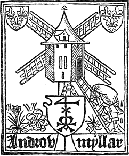|
Cover of 'Introduction of the Art of Printing into Scotland' by Robert Dickson. (enlargement) | 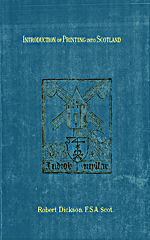 |
Fifty Copies printed on Large Paper.
Large Paper, No. 18.
[ p.iii ]
OF THE
ART OF PRINTING INTO SCOTLAND.
[ p.v ]
OF THE
Art of Printing
INTO
SCOTLAND
BY
Robert Dickson, F.S.A., Scot.
Aberdeen
J. & J. P. EDMOND & SPARK
1885
[ p.vi ]
TO
MONS. A. CLAUDIN (PARIS)
WITH EVERY MARK OF RESPECT AND GRATITUDE
BY HIS
GREATLY OBLIGED FRIEND
ROBERT DICKSON.
| I |
I am quite aware of the literary defects of the volume, which would have been more numerous had not one of my publishers, Mr. J. P. Edmond of Aberdeen, undertaken to / p.x / revise the work for the press. It is impossible for me to express my indebtedness for the amount of laborious trouble he has kindly undertaken, or the successful issue to which he has brought his labours.
To Mr. John Small, Librarian of the University of Edinburgh, I am indebted for obtaining for me, permission to take photographs of the title and other pages of the Aberdeen Breviary, without which this volume would have been deprived of much of its interest. To the skillful pen of Mr. Charles F. Glegg, I am indebted for many of the illustrations exhibited, which I gladly acknowledge in a succeeding page. To the Rev. James Innes, M.A., of the Free Church, Panbride, I have pleasure in expressing my thanks for preparing for me the excellent translations from the Latin, which will be found on several of the pages. To Mr. Clark, of the Advocates' Library, Edinburgh, I must express my warmest thanks for allowing me such valuable use of the volume containing Chepman and Myllar's unique collection of pieces, and of / p.xi / any Scottish work I desired, to enable me to follow my interesting researches in Scottish typography.
Concerning the facsimiles, I have to thank Mr. D. C. Dallas, London, for their production by a process which he has worked out for himself, after experimenting at least twenty years, and which seems admirably adapted for the purpose.
CARNOUSTIE, N.B.
[ p.xiii ]
| PAGE |
| PREFACE . . . . . . | ix |
| LIST OF ILLUSTRATIONS. . . . . . | xv |
| INTRODUCTORY. . . . . . | 1 |
| WALTER CHEPMAN. . . . . . | 13 |
| ANDROW MYLLAR. . . . . . | 25 |
| MYLLAR IN FRANCE. . . . . . | 31 |
| MYLLAR A GENUINE PRACTICAL PRINTER. . . . . . | 41 |
| THE ABERDEEN BREVIARY. . . . . . | 61 |
| M. A. CLAUDIN'S LETTERS TO THE AUTHOR . . . . . . | 77 |
| PATENT, OR PRIVILEGE, GRANTED BY JAMES IV. TO CHEPMAN AND MYLLAR. . . . . . | 93 |
| INDEX. . . . . . | 95 |
[ p.xv ]
| DRAWN BY | PAGE |
| DEVICE OF ANDROW MYLLAR, Reduced | Titlepage |
| COLOPHON OF THE MAYING AND DISPORT OF CHAUCER . . . . . . | 4 | |
| TITLE OF DO. . . . . . . | 4 | |
| LAST PAGE OF TEXT OF DO. . . . . . . | 5 | |
| COLOPHON OF PORTEOUS OF NOBLENES . . . . . | 7 | |
| COLOPHON OF KNIGHTLY TALE OF GOLAGROS AND GAWANE . . . . . . | 7 | |
| TITLE OF THE GOLDYN TARGE . . . . . . | 7 | |
| TITLE OF TREATISE OF ORPHEUS AND EURYDICE | 8 | |
| TITLE OF BALLAD OF LORD BARNARD STEWART | 8 | |
| DEVICE OF WALTER CHEPMAN . . . . . . | 12 | |
| SEAL AND SIGNATURE OF WALTER CHEPMAN . . | 22 | |
| DEVICE OF ANDROW MYLLAR . . . . . . | 24 | |
| TITLE OF EXPOSITIO SEQUENTIARUM . . . . . . | 30 | |
| COLOPHON OF DO. Block sent by M. A. Claudin | 32 | |
| TITLEPAGE OF GARLANDIA, 1505. Block sent by M. A. Claudin . . . . . . | 35 | |
| COLOPHON OF GARLANDIA, 1505. Block sent by M. A. Claudin . . . . . . | 38 | |
| DEVICE OF PHILIPPE PIGOUCHET . . . . . . | 45 | |
| COMPARISON OF TYPES IN THE UNIQUE VOLUME IN ADVOCATES' LIBRARY . . . . . . | 48 | |
| BEGINNING OF DUNBAR'S LAMENT FOR THE MAKARS . . . . . . | 50 | |
| DEDICATION OF PETRUS RAVENNAS, by Herman Bumgart, (slightly larger than the original) . . . . . . | 52 |
/ p.xvi /
| FIRST PAGE OF THE GEST OF ROBYN HODE . . . . | 53 | |
| SECOND PAGE OF THE GEST OF ROBYN HODE . . | 55 | |
| DEVICE OF HERMAN BUMGART, COLOGNE . . . | 58 | |
|
BEGINNING OF FIRST PSALM, BREVIARIUM ABERDONENSIS, 1509 . . . . . . | 64 | |
| TITLE OF THE ABERDEEN BREVIARY, 1509 . . . . | 65 | |
|
PENULTIMATE PAGE, WITH COLOPHON, FIRST VOLUME OF BREVIARIUM ABERDONENSIS . . | 69 | |
| DEVICE OF THOMAS DAVIDSON . . . . | 74 |
INTRODUCTION.
| I |
/ p.2 /
The copy of the Breviarium Aberdonense presented to the library of the University of Edinburgh in 1635, by the candidates for the Mastership of Arts, must have acquainted those versed in the study of books that the volumes were printed in Edinburgh in 1509 and 1510, at the command and expense of Walter Chepman, burgess and merchant in the said city; and, consequently, that there was a printing-press thus early in Scotland. But the existence of this work appears to have been afterwards lost sight of, as Watson, who published "A History of the Art of Printing,"*
---------------------------
* James Watson, a Printer of some note in Edinburgh, about the beginning of last century, published a small 8vo. volume in 1713, entitled the History of the Art of Printing, &c., which contains a lengthy Preface, written by Mr. John Spotswood, Advocate and Professor of the Law, wherein he undertakes to relate the Beginning, Progress and late Decay of our Art in this part of our Island. He says, "we had Printing very early here, nor could we miss being soon let into that Art, having, at the time of its Invention, a close and constant Trade with the Low Countries. And, if Printing was first invented at Haarlem, we, who had a staple Port at Antwerp, might possibly have it as soon as any of their Neighbours. And that we had it from Holland is clear from our Cases and Presses being all of the Dutch make, till of late years; and, from our manner of working, in distributing the letter in the Hand with the Face from us, and the Nick downwards, and our making Ink as the Printers there do."—page 7. The writer has evidently no idea how far behind Scotland was in introducing the Typographic Art. He supposes, apparently, that it was introduced long before it was, and he accounts for the absence or scarcity of specimens of the productions of the earlier Printers, by conjecturing "that these were either Books of Saints Lives and Legendary Miracles, or Books of the Devotion then in vogue, or / p.3 / against the first Reformers. All which kind of Books were either carried away by Priests who fled beyond seas, or were destroyed by our Reformers in the heat of their zeal. However, there are some pretty old ones yet to be seen, such as Scotland's Complaint, printed at St. Andrews in the year 1540. And that Printers were numerous here at that time is evident from an Act of Parliament held in the year 1540, impowering the clerk of the Register to print the Acts of the Parliament that concern the common weill, by what printer he shall please, within the Realm."—pp. 7. 8.
---------------------------
/ p.2 / in 1713, was evidently not / p3 / aware of so early a Scotch-printed book; and, indeed, was otherwise ignorant regarding the establishment of our primitive press.
---------------------------
The volume contained eleven separately printed pieces, or small quarto books, some of which indicated the printers, place, and date of printing. These pieces proved that in 1508, the year before Walter Chepman printed the first volume / p.4 / of the Aberdeen Breviary, he was associated with Androw Myllar in the production of the pieces referred to. The earliest dated piece in the volume is sixth in the order in which they are bound, and has the following colophon:—
In 1788 a volume was presented to the Advocates' Library, which threw additional light upon our early printed literature.*
* I have frequently been assured by the late Dr. Laing that the presentation of this unique volume was made by a Dr. Farquharson on behalf of a Mr. Alston of Glasgow. The book itself was picked up in Ayrshire in 1785.
---------------------------

(enlargement)
This is the most complete piece in the collection, having, besides the colophon given, the entire text, and a short anonymous poem at the end; the title is as follows:—

(enlargement)
It is printed over the device of Walter Chepman on the recto of the first leaf, and the device of Androw Myllar is on the reverse of the last leaf. The colophons of the other two pieces which possess them, show that they were both printed in April, 1508. Once of these two, The Porteous of Noblenes, the first in the order in which the collection is bound, has this colophon on recto of
[ p.5 ]
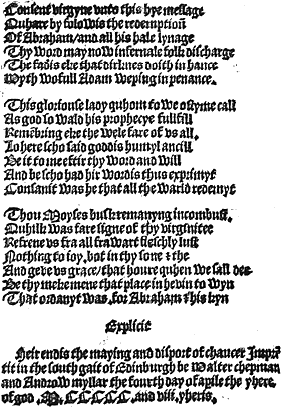
Last page of the Maying and Disport of Chaucer; Chepman and Myllar, 1508
(enlargement)
/ p.7 /
last leaf:—

(enlargement)
The colophon of the other dated piece, which is second in the volume, is:—

(enlargement)
The remaining six pieces which are undoubtedly from the same press, may be assigned to the same year. They are Syr Eglamoure of Artoys (III.), which has neither title nor colophon; The Goldyn Targe (IV.), which is one of the two complete pieces in the collection, and has the following title:—

(enlargement)
The Buke of Gude Counsale to the King (V.); The Flyting of Dunbar and Kennedy (VII.); / p.8 / The Tale of Orpheus and Eurydice (VIII.), with this title:—

(enlargement)
and lastly, The Ballad of Lord Barnard Stewart (IX.), which has the following long title above Chepman's device:—
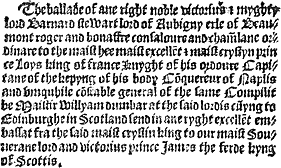
(enlargement)
Concerning the other two pieces in the volume we will have some interesting remarks to make later on.
Herbert was fortunate enough to obtain from George Paton, Edinburgh, a very exact account of the collection in question, so that it found a / p.9 / place in the appendix to the third volume of his great work, which was published in 1790.*
---------------------------
* The Typographical Antiquities of England, 3 vols., 4to., 1785-90.
---------------------------
George Chalmers, who was already advanced in his typographical researches when Herbert concluded his extensive labours, applied himself with fresh diligence to obtain further information regarding the introduction of printing into Scotland. He was able to go back, by means of the unique volume just referred to, as far as the year 1508; and he believed that by searching the records deposited in the General Register House, Edinburgh, some additional knowledge would be acquired upon the subject. With this hope he solicited his friend, Mr. William Robertson, one of the functionaries in that establishment, to aid him in his efforts, and that gentleman had the satisfaction of discovering a document which might be said to place the matter at rest. The document was no other than the Patent, or Privilege, granted by James IV. to his "lovitis servitouris Walter Chepman and Andro Myllar, burgessis of our burgh of Edinburgh," and "geven under our prive Sel at Edinburgh, the xv day of September, and of our Regne the xxti yer" (1507). It states that these individuals / p.10 / "hes at our instance and request, for our pleasure, the honour and proffit of our Realme and Liegis, takin on thame to furnis and bring hame ane prent. with all stuff belangand tharto, and expert men to use the samyne, for imprenting within our Realme of the bukis of our Lawis, actis of parliament, croniclis, mess bukis, and portuus efter the use of our Realme, with addicions and legendis of Scottis sanctis, now gaderit to be ekit tharto, and al utheris bukis that salbe sene necessar," &c. It is not essential here to refer more particularly to this most important document. *
---------------------------
* See Appendix B., where it is given at length.
---------------------------
further than to observe that we are not aware of any other monarch, in the early days of printing, having been so directly instrumental in introducing the typographic art into his kingdom.
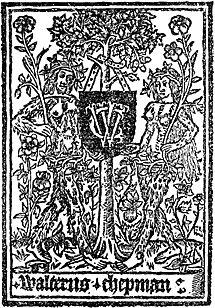
Device of Walter Chepman.
(enlargement)
WALTER CHEPMAN.
Walter Chepman, as we have already stated, was a merchant-burgess of the city of Edinburgh, and the presumption is that he was a native of that place. Of his parentage or earlier years we know nothing, and it is not until 1494 that we become acquainted with him, and when he would probably be in the prime of life. He was a man who must have added to excellent natural abilities an education vastly superior to that of the or- / p.14 / dinary class of merchants of the period. His tact, prudence, and thorough business habits, early recommended him to the notice of James IV., whose friendship and favour he had the good fortune to retain. He was frequently employed as a writer of the King's letters, and he enjoyed the honour of being entrusted with the custody of the King's signet. On several occasions he was chosen to conduct negotiations of delicacy and trust, and once, at least, he was sent, along with Stobo, a notary public, on a mission of importance to the English court. Although he engaged in many different kinds of commercial transactions, he was always more or less directly attached to the King's household; and on the occasion of James's marriage in 1503, he obtained, at the expense of the privy purse, a suit of livery made of English cloth.
As a general merchant and importer, Chepman traded in wood for shipbuilding and other purposes, in wool, cloths, velvets, damasks, and a variety of other merchandise. He strove to make money in many honest and honourable ways, and in any direction which promised the prospect of increasing his worldly substance. Hence it is not wonderful that we find him / p.15 / willing to gratify the king and the Bishop of Aberdeen by undertaking to assist in establishing a printing press in Edinburgh. He was already a man of wealth and property, and therefore able to bear the outlay which such an undertaking would involve. But he expected, no doubt, to be handsomely reimbursed, and he could not but believe that, as a printer, he ought to succeed, seeing that he was assured of royal and episcopal encouragement, and would have his position fenced about with legal securities. Although, it is unlikely that he was acquainted with the practical details of the art, his ignorance in this respect would not be allowed to stand in the way, as he would import a staff of skilled workmen, over whom his coadjutor, Androw Myllar, would exercise a diligent supervision.
In the acquisition of wealth Chepman appears to have been fairly successful, and in 1505 he began to invest his capital in land. In May of that year he purchased the forty shilling freehold estate of Ewerland, within the manor of Crammond Regis, from co-heiresses of the name of Dais; and in the following year he acquired from the abbot and monks of Culross a life-rent of the lands of Meikle-Jergeray, in Perthshire, for / p.16 / himself and his wife Agnes Cockburne, which he held till his death in 1528, but which his widow appears to have retained for only nine years afterwards. In 1509 he purchased from James Wardlaw, of Riccardton, the estate of Priestfield, now Prestonfield, on the south side of Edinburgh.
He possessed several tenements of lands and houses within the city, in one of which, at the foot of the Blackfriars Wynd in the Southgait or Cowgate, he and Myllar erected their printing press. At the top of the said wynd, in the High-street, he likewise possessed a property—his dwelling-house apparently, upon which, in 1510, he obtained the king's permission to make extensive alterations. Another tenement which he held in the Southgait he afterwards gave up for pious purposes.
In 1514 and 1515, Chepman held the office of Dean of Guild of Edinburgh, a position for which his well-known business habits and respectable character as a merchant-citizen so justly fitted him. Yet his official connection with the civic authorities did not exempt him from being called upon to show cause why he had departed from an obligation he had entered into to erect certain buildings on the Borough- / p.17 / muir. He appears, however, to have satisfied the magistrates that he had erected all he had undertaken to build, in order to fulfil certain designs they had in view. As the buildings referred to were those in connection with a brewery, it would seem as if Chepman had some direct interest in the concern.
We have stated that he had the good fortune to retain the patronage of his sovereign, James IV., and it is a significant proof of the worthiness of Chepman's character, that he was privileged to receive special marks of favour from James V. In 1511, the former king granted him exemption from watching and warding, duties which the inhabitants of the city were called upon, in turn, to perform. He was also exempted form paying stent (a kind of property tax), from attending the king's army, or from bearing any office in the city of Edinburgh against his own consent. All these exemptions were continued by James V. during Chepman's life, and several of them were enjoyed by his widow.
In 1526, the king gave Chepman a grant of a tavern and booth on the north side of the High-street, which had escheated to the Crown by the death of John Cockburne, a bastard, and into / p.18 / which he placed one Isabel Harper. The tavern had been reserved by the king when he came of age, by an act of general resumption, and in March, 1542, most probably after the death of Chepman's widow, the king granted the same premises to another printer, Thomas Davidson. In the same year he obtained a charter of the king's meadow, in feu farm, to himself and to his wife for life, and to their son David, in fee; paying therefor the sum of lib. 14 scots.
From the brief narrative of these details it will be seen that Chepman was a man of property, respectability, and consideration. It is pleasing to be able to add that "no inconsiderable portion of his wealth was devoted to religious purposes. In the last year of the reign of James IV., when the celebrated Gawin Douglas was Provost of the Collegiate Church of St. Giles's, Edinburgh, Chepman erected an aisle on the south side of that church, and there endowed an altar for a priest to officiate, and pray for the salvation of the souls of the king, the queen, for himself, his wife, and also his former spouse, and other relations, according to the usual form of such endowments. It was confirmed under the Great Seal on the 21st August, 1513. Scarcely / p.19 / three weeks elapsed when the sad tidings of the king's fate at Floddon reached Edinburgh.
"Fifteen years later, towards the close of his own life, Chepman exhibited a fresh instance of his attachment to his old master. Having endowed a mortuary chapel in the lower part of the cemetery of St. Giles's Church on the 12th of August, which was confirmed under the Great Seal on the 16th of September, 1528, the priest was enjoined to offer prayers, as usual, not only for the souls of the reigning king, for the founder and his wife, Agnes Cockburne, and for Margaret Kerkettle or Carkettle, his former spouse, but ESPECIALLY FOR THE REPOSE OF THE SOULS OF THE KING, AND NOBLES, AND HIS FAITHFUL SUBJECTS WHO WERE SLAIN AT FLODDON."
Chepman does not appear to have survived many months after the confirmation of this pious endowment. About ten years ago Dr. Laing discovered in an old Protocol Book an entry which determines this point pretty accurately. It is there stated that on the 2nd of April, 1529, "proba mulier Agnes Cockburne, relicta quondam Walteri Chepman," appeared and delivered to David Chepman, so and heir of the late Walter Chepman, all and whole the goods, / p.20 / moveable and heritable, pertaining to the said David by reason of the death of his said late father, &c. At the same time David Chepman conveyed the silver work specified, and other moveables, in free gift to his mother, Agnes Cockburne.*
---------------------------
* "Life and Poems of William Dunbar," a work in which the learned editor, Dr. David Laing, displays that thorough research and genial sympathy with his author which characterise all his labours in illustration of the lives and productions of our earliest writers. The "Supplement" to the above work contains an interesting notice of Walter Chepman.
---------------------------
Chepman was buried in his own aisle in St. Giles's Church; and as he had been honoured and esteemed during life, his interment would doubtless be attended with every mark of respect and solemnity of feeling.†
---------------------------
† The labours of the late Dr. Wm. Chambers, a worthy follower of Chepman, in bringing to light the tomb of Walter Chepman, and his benevolent efforts in restoring the interior of St. Giles's Cathedral, will always remain as memorials of a great man, who has done so much towards the introduction and diffusion of a cheap and sound literature, with which his name will ever be worthily remembered.
---------------------------
We are afraid, however, that his remains were afterwards disturbed by certain proceedings which took place in 1579, when the magistrates of the city "grants and permits that upon the west part of Walter Chepman's Iyle fernent the Erle of Murray's tomb salbe broken, and thair ane buriall place be maid for the Erle of Athole." The exact / p.21 / locality of Chepman's resting-place is here sufficiently indicated to enable us to point it out at the present day.
The deeds of endowment quoted above make us acquainted with the fact that Chepman was twice married; first to Margaret Kerkettle (who must have died before 1506), and again to Agnes Cockburne, who survived him thirteen or fourteen years. He left a son David, who was a merchant in Edinburgh, and among other branches of industry which he followed he appears to have been a bookbinder, as we find that in March, 1539, the king's treasurer paid him ten shillings scots for "binding and laying about with gold the queen's matin buke." A nephew of Chepman's, named John Chepman, was a burgess of Edinburgh and a Writer to the Signet. He seems to have been a man of property, and imitated the works of piety of his uncle. In 1537 he granted an annuity of thirty-one merks, out of certain lands and tenements in Edinburgh, for the support of a chaplain at the Altar of St. John, in the aisle built and founded by his uncle.
John Chepman's wife was named Isobel Henderson. Her name is mentioned in the deed of 1537, and the witnesses are David, Thomas and Robert Chepman. He reserves the patronage / p.22 / of the chaplaincy to himself, the heirs male of his body, his heirs male whomsoever bearing the name of Chepman, his eldest heir female, &c. The chaplain to be one of his own name if any be found of it; if not, a relative not bearing the name to be preferred to a stranger.*
---------------------------
* Scottish Arms, ed. by R. R. Stoddart, Edinb., 1881, Vol. II., p. 143.
---------------------------
Of Chepman's widow it is enough to say that she continued to engage in business of one kind or another for at least thirteen years after her husband's decease, and that the king was invariably favourable to her prosperity.
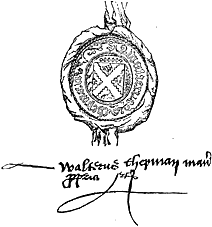
Seal and Signature of Walter Chepman.
( enlargement)
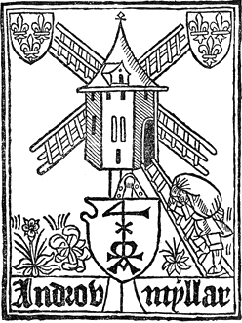
Device of Androw Myllar.
(enlargement)
ANDROW MYLLAR.
| R |
---------------------------
* The books supplied were:— Decretum Magnum; and Decretalis Sextus cum Clementini Scotus super quatuor libris.
---------------------------
on the 22nd December, / p.26 / 1507, fifty shillings were paid by the king's treasurer "for iij prentit bukis tane fra Andro Myllaris wyf"; and the last time we see his name is in the colophons of the productions which issued from his own and his associate Chepman's press in 1508.
These few particulars were really all we knew concerning Myllar and from them we could gather that he was either a bookseller, or added the sale of books to whatever occupation he followed. It is evident that he was out of the country in December, 1507, when the "iij prentit bukis were tane fra Andro Myllaris wyf."
For us, the circumstance in the lives of both Chepman and Myllar which has the chief interest, is their direct connection with the introduction of the art of printing into Scotland. We have seen that it was at the instance of the king, James IV., himself, that these two individuals undertook to establish a printing press. Our surprise is, that with his strong love for learning and literature, that monarch did not seek to introduce the art into his kingdom at an earlier period of his reign than 1507. We know that he was the fond patron of men of learning and science, and that he himself was no mean scholar, / p.27 / since he was able to speak half-a-dozen languages, besides Latin. He had collected a considerable library of printed and written books; and he appears, indeed, to have been an ardent bibliophile, if we may judge by his fondness for sumptuously illuminated and bound volumes. His books were bound in vellum, rein-deer hide, velvet, and other materials, and many of them were lettered with gold, and otherwise ornamented in a costly style. He employed the most skilful scribes in the country in copying rare and favourite works; and he displayed in everything relating to literature a taste and refinement not common in Scotland in those rude times. The utility and value of the printing press would obviously often occur to him, and we may take it for granted that the question of introducing the typographic art had been frequently considered by him. But not until some special purpose called for decided action in the matter did he definitively resolve upon it. And this purpose came in due course, when Bishop Elphinstone had prepared his Breviary for the press. In selecting Chepman and Myllar as his active agents, James would be guided by his personal knowledge of their character and qualifications; / p.28 / and he must have had full confidence in their ability to carry out his wishes. That they were worthy of this confidence, and that they entered upon their work in good earnest, is evident from the fact that within seven months of the date on which the king granted the patent, several small productions had left their press.
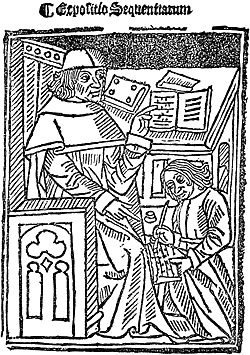
Titlepage of the Expositio Sequentiarum, 1506.
(enlargement)
MYLLAR IN FRANCE
| I |
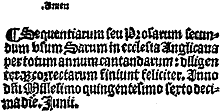
(enlargement)
This catalogue fortunately came into the hands of the late Dr. David Laing, who at once recognised the device as that used by Androw Myllar in the books printed by him and Chepman in 1508. Dr. Laing urged the authorities of the British Museum to endeavour to secure the Book of Sequences at the sale; and this they had the satisfaction of doing, although at a cost of £40. This living, speaking witness is so interesting and important in the history of Androw Myllar, that we venture to consider such testimony cheaply purchased. The work in question does not indicate where it was printed, nor does it give the printer's name, further than that of Androw Myllar on the sill of the device; but M. Claudin, after a comparison of types, discovered that the book was printed with the / p.33 / characters used by Laurence Hostingue, who exercised his art, along with Jamet Loys, in Rouen, at the date specified.*
---------------------------
* Laurentius Hostingue and Jametus Loys printed an edition of Vocabula Magistri Stanbrigii, at Touen, in 1510, for Martin Coessin, dwelling at Exeter. Martin Coessin had also printed at Rouen, at his own expense, Cato cum Commento, by Richard Goupil. See Ames, p. 486, and Herbert, p. 1530.
---------------------------
Although it might be somewhat rash to conclude form the mere presence of the device that Myllar was the actual printer of the book, yet, why this mark? Looking at it, however, in connection with what we do know of him in 1508, we feel less hesitation in attributing the production of the work to him; but any doubt we might have on this point, and especially concerning the fact that Myllar was a thoroughly-trained practical printer, is at once set at rest by the conclusive evidence which we will immediately set before our readers. Before proceeding to the consideration of this, we cannot help noting the curious and interesting coincidence, that the device of England's proto-typographer should be first found in a liturgical work printed for him by William Maynyal at Paris in 1487; so that Caxton's hitherto undeciphered device, as well as Myllar's punning one, had a French origin; / p.34 / a conclusion which might easily be established regarding Myllar's, from the circumstance that it displays two small shields at the top corners, each charged with three fleurs de lis.*
---------------------------
* It is but right to note that shortly after the closing of the London Caxton Exhibition, M. Claudin sent an interesting letter regarding the work above referred to, and its printer, to the editor of La Typologie, Tucker, 15th Nov., 1877, which contains many particulars concerning Androw Myllar.
---------------------------
As soon as M. Claudin, who is of Scotch extraction, learned that Myllar was a Scotchman, he redoubled his efforts to obtain further information regarding him, and early in 1878 he was rewarded by discovering that Myllar was actually the printer of a book in 1505. One can imagine the feelings of such a thorough-paced bibliograph as M. Claudin when he stumbled upon a work which yielded all the information he desired. Here is the title of the said volume, which had hitherto escaped the notice of every previous writer:— "Multorum vocabulorum equiuocorum interpretatio. Magistri Johannis de Garlandia: grammatico & latini cupido per maxime necessaria Incipit." Translated literally, it would read:— "The interpretation of many ambiguous words by Master John of Garland: indispensably needful to the Grammarian and lover of Latin,
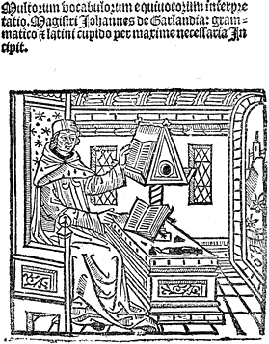
Titlepage of Garlandia, 1505.
(enlargement)
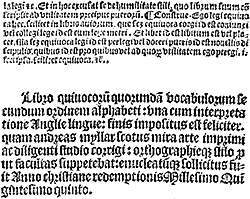
Colophon of Garlandia, 1505.
(enlargement)
/ p.39 /
Begins." The work is a black-letter quarto of sixty-two folios and bears this colophon, "Libro quivocoru quorunda vocabulorum secundum ordinem alphabeti: vna cum interpretatione Anglie lingue: finis impositus est feliciter. quam andreas myllar scotus mira arte imprimi ac diligenti studio corrigi: orthographieque stilo prout facultas suppetebat: enucleatuque sollicitus fuit Anno christiane redemptionis Millesimo Quigintesimo quinto." Translation :—"The book of certain ambiguous words, in alphabetical order: along with an English translation, has reached a successful close. (All of) which Androw Myllar, of Scotland, has taken care to have printed with marvellous skill, and corrected with painstaking zeal: and in orthographic writing according to the measure of his ability, and freed from obscurity. In the year of the Christian Redemption One Thousand Five Hundred and five." There is no place of printing noted, but we may safely assume that Rouen was the locality where the book had its birth. The volume was discovered by M. Claudin in a private library at Dinant in Bretagne; and at the sale of the collection the volume was purchased by M. Claudin, for the Bibliotheque / p.40 / Nationale, at the very moderate price of £16 or £17. It is very satisfactory to know that this priceless volume is now in a National collection, and accessible to students.
PRINTER.
MYLLAR A GENUINE PRACTICAL
| T |
/ p.42 /
We must suppose that Chepman was quite aware of Myllar's qualifications, and would arrange to join him in establishing a printing press in Edinburgh. It might even be that Myllar had gone abroad to make himself master of the art for the very purpose of returning to his native country and introducing it here. Chepman was undoubtedly alive to the usefulness of a local press, and he took advantage of a combination of circumstances, which arose in 1507, to favour its establishment. Myllar was prepared, as far as experience went, and doubtless quite willing to assist in the erection of a press in Edinburgh. Chepman knew that Bishop Elphinstone had the Breviary of Aberdeen ready for the press, and that he would rather have it printed under his own immediate inspection; William Dunbar had plenty of poetry on hand, which he would have no objection to see in print, and the king himself was in every way favourable to the introduction of a press into his kingdom. It is a matter of small moment whether we allow that the king took the initiative in the matter, and that it was really "at his instance and request, and for his pleasure," that Chepman and Myllar undertook to establish a press in Edin- / p.43 / burgh, or that he was prompted to the good purpose by the literary worthies above named. We may take it for granted that Chepman had made the king acquainted with the important fact that Androw Myllar was ready to come home and undertake the practical management of the printing-office, and that the opportunity was therefore at hand for the immediate introduction of the art. We are inclined to think that, but for this preparedness on Myllar's part, the establishment of a printing-press in Edinburgh might have been indefinitely postponed. It is significant to note that in December, 1507, a few weeks after the king had granted the Privilege, Myllar was not in the country. We imagine that he was in Rouen, the school where his practical knowledge of printing had been acquired, providing himself with all the essentials which were necessary to enable him to make a start in Scotland. He would select one or two of his old shop-mates to accompany him—men experienced in the various branches of the typographic art, and with whom he would be able to converse freely in their native tongue.
Among the "stuff" belonging to the printing materials "brocht hame" by Myllar, we must / p.44 / particularly notice the woodcut device of Walter Chepman.*
---------------------------
* Represented in facsimile, facing page 13.
---------------------------
It is French to the back-bone, and has the principal portions of it borrowed from the mark of Philippe Pigouchet, of Paris. The male and female figures are faithfully copied, even to the small crosses on their knees. The shield has the initials W C very elegantly interlaced in the style of the S V upon Simon Vostre's; but, in Chepman's, the tree from which the shield depends is an oak bearing several acorns, while in Pigouchet's it resembles a palm bearing a large globular fruit. Chepman's wants the ornamental border, and instead of the chaste letters composing the name of Philippe Pigouchet on the scroll, we have "Walterus Chepman" in a somewhat heavy black letter.
Myllar's device†
---------------------------
† A facsimile, actual size, faces page 25.
---------------------------
may be described here. It is a trifle larger than Chepman's, and displays a windmill, with a miller ascending the outside ladder, carrying a sack of corn on his back. A shield, suspended from the stem of the mill, contains a monogram combining all the letters of Myllar's surname. In each of the
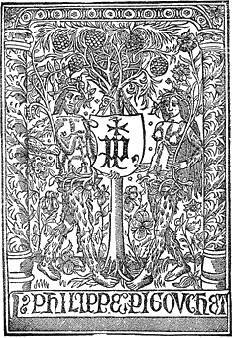
Device of Philippe Pigouchet.
(enlargement)
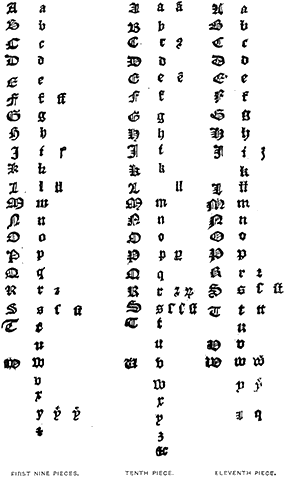
Comparison of types.
(enlargement)
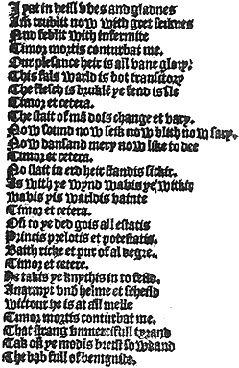
Part of the Tenth Piece.
(enlargement)
/ p.51 /
upper corners of the device is a small shield, charged with three fleurs de lis, and in the compartment at the lower margin of the mark is the name of the printer, "Androv myllar," in large Gothic characters.
Chepman's device is found in four of the first nine pieces in the interesting volume so often referred to, and Myllar's in seven. The text is printed with types which have a genuine Norman character, and were likely cut specially for the new Scottish press. The tenth piece is printed with the same characters as are found in many parts of the Expositio Sequentiarum of 1506, which we described in the previous chapter. It wants the beginning and the end, but may fairly be attributed to Myllar's foreign press. The eleventh piece, entitled, "Here begynneth a gest of Robyn Hode," in which twelve leaves, not consecutive, are present, but the end wanting, is printed with a type identical with that occasionally used by Herman Bumgart, who exercised his art at Cologne about the end of the fifteenth century. We were led to this conclusion by examining a copy of Petrus Ravennas, Compendium Juris Civilis, which we purchased in October, 1880, and boldly expressed our belief / p.52 / in the identity of the types in the little treatise, Who Was Scotland's First Printer? published in January, 1881. Mr. Bernard Quaritch was at pains to corroborate our views regarding the identity of the types, and on the 11th May, 1881, wrote as follows:— "The gest of Robyn Hode, to judge from the twelve lines you have chosen,
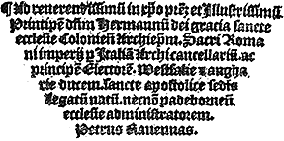
From Petrus Ravennas, Compendium, c.1495-99.
(enlargement)
is in the very type in which Herman Bumgart printed a religious treatise—Van xii fruchte misse zo hoeren. The colophon of this book does not bear either his name or date, but it has the subscription, 'Gedrucht in Coelne up den Alden Mart tzo dem wilden manne,' which corresponds exactly to the subscription of your Petrus Ravennas, 'super antiquum forum in silvestri viro.' Holtrop, in his catalogue of the Royal Library at the Hague, describes the
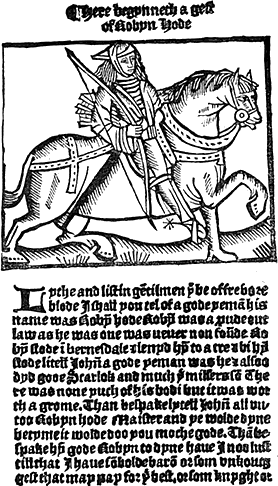
First Page of the Gest of Robyn Hode.
(enlargement)
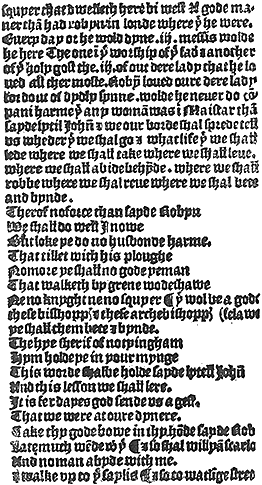
Second Page of the Gest of Robyn Hode.
(enlargement)
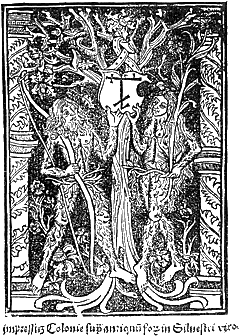
Device of Herman Bumgart.
(enlargement)
/ p.59 /
Petrus Ravennas as printed by Herman Bumgart about 1495-99." What connection this piece has with the others we have not been able to make out.*
---------------------------
* Dr. David Laing accepted our opinion in reference to these two last pieces, and in the Catalogue of the Caxton Exhibition, 1877, at page 36, after a brief notice of this unique volume—which was lent by the Faculty of Advocates— and the enumeration of the several pieces, there is added, "Excepting the two last tracts, all the above are from the press of Chepman and Myllar."
---------------------------
It is impossible to over-estimate the value of this volume, containing so many unique relics of our earliest press, since, but for its fortunate preservation, we would have had no proof that the printing-press had been in operation in Scotland so early as April, 1508, or any evidence that Walter Chepman and Androw Myllar had ever printed in company, or that Myllar ever printed in Scotland at all.
It is to be regretted that research has hitherto failed to discover any trace of Myllar after the date on which his name appears in the colophons of his own works (April, 1508). The veil of obscurity, therefore, enshrouds the last days of his life, and we are left to conjecture what we please respecting his fate.
We have said enough, we think, to show that Androw Myllar was a trained practical printer, and that when he came to Edinburgh to establish / p.60 / its earliest press, he had several years of technical experience to aid him. Chepman, on the other hand, had had no opportunity of acquiring a practical knowledge of printing, and we believe that when the Southgait press was put in operation, he was entirely ignorant of the details of the art. But he has undoubted claims to our regard, inasmuch as he was the monied partner in the concern, and supplied the capital, without which the enterprise could not have been carried on. He encouraged the art, like many generous spirits in the early days of printing, but, nevertheless, he was not a printer. He has no claim to be regarded as the "Scottish Caxton," and no title to be ranked among the grand old masters of typography. Androw Myllar, however, stands in a different light. Little by little the evidence has been gathered together, and although the sum may appear small, yet the certainty is great that it was he who first introduced the Art of Printing into Scotland.
THE ABERDEEN BREVIARY.
| T |
/ p.62 /
Although the part played by the good Bishop in the production of the Breviary is quite clear, it is singular that we are left in doubt as to the actual printer of what is, so far as we know, the most important work that issued from the first Scottish press. We know that it was at Chepman's command and expense that the two volumes were printed in 1509 and 1510, but we cannot with certainty advance beyond this.
The titlepage and colophons refer to him in terms which deserve consideration in weighing the evidence whether or not Chepman was the actual printer of the book, and we have prepared facsimiles of these from photographs made by permission of the University of Edinburgh, from the copy in their possession. We believe it is the first time that actual facsimiles of this work have been produced; the reprint of the Breviary published in 1854, although a magnificent specimen of typography, is so very much larger than the original, that it conveys a false idea of the appearance of the page.
In size the Breviary is an octavo, 5¾ inches in height, and 3¾ inches broad; the first volume, Pars Hyemalis, contains in all 400 leaves, and the second volume, Pars Æstiva, 377 leaves. / p.63 / Although four copies of the Breviary are known, yet all are defective, and it would be impossible to form a complete copy out of the whole. Of the four copies, that in the University of Edinburgh is the only one possessing a title, and that only to the first volume. A second copy is in the Advocates' Library, the third is the property of the Earl of Strathmore, and the fourth is an imperfect copy of the first volume in the University Library, Aberdeen.
The type in which the text of these volumes is printed is a small black letter, seventeen lines going to the space of two inches. There are a number of elegant capitals of the kind known as Lombardic, or Missal, and of these there are as many as four sizes of the same letter. They are generally printed in red, and have a bold imposing effect. The page has, therefore, a pleasing display of contrast; but the printing is very unequally executed, for while some of the pages have the text brought out beautifully clear and sharp, there are many which are blurred and disagreeable to look at. The only florid letter in the volumes is on the recto of folio ij of the Psalterium. It is the initial B, of Beatus vir of the first psalm, a letter which almost all our early / p.64 / typographers delighted to embellish. Chepman's is very elegant, measuring a little more than three-quarters of an inch square.
Freed from the numerous contractions, the titlepage is as follows:—Breviarii Aberdonensis ad percelebris ecclesie Scotorum potissimum usum et consuetudinem Pars hyemalis: de tempore et de sanctis ac davitico psalterio congruenter

Part of Folio ij Psalterium, Breviarium Aberdonensis.
(enlargement)
per ferias diviso: cum Invitatoriis hymnis Antiphonis capitulis Responsoriis horis feriarum commemoracionibus per anni curriculum necnon commune sanctorum plurimarumque virginum & matronarum ac diversorum sanctorum legendis quæ sparsim in incerto antea vagabantur: cum Kalendario et mobilium festorum tabula perpetua variisque aliis adjunctis & de novo additis sacerdotibus plurimum quam necessariis in Edinburgensi oppido Walteri chepman mercatoris impensis impressa Februariis idibus. Anno
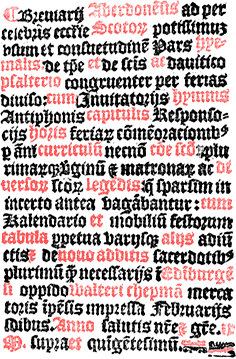
Titlepage of Breviarium Aberdonensis, Pars Hyemalis.
(coloured manually)
(enlargement)
/ p.67 / salutis nostre et gratie. ix. M. supra et quingentesimum. Translation :—The winter section of the Aberdeen Breviary principally for the use and practice of the very famous Church of the Scots: for the season and for the saints, with the Davidic psalter suitably divided for the ferial days: with the Invitatories, hymns, Antiphons, chapters, Responses for the hours of the ferial days and for the commemorations throughout the course of the year, As also the common of saints and of very many virgins and matrons, and the legends of various saints, which were previously scattered about in an uncertain way: with a Kalendar and perpetual table of the moveable feasts, with various other appendices and new additions of the greatest possible necessity for priests. Printed in the town of Edinburgh at the expense of Walter Chepman, merchant, on the ides (13th) of February in the year of our salvation and of grace nine above the thousand and five hundredth (1509).
The colophon to the first volume is on the verso of the next to the last leaf of the book, and is shown in the facsimile opposite. It may be translated thus :—The end of the winter section of the Aberdeen Breviary chiefly for the / p.68 / use of the Scottish Church, by the care and at the expense of the honourable man Walter Chepman, merchant of the city of Edinburgh in Scotland. On the Kalends (1st) of February, in the year 1509 after the birth of Christ, in the twenty-second year of the reign of James the fourth, the most illustrious king of the Scots.
Perhaps the most important evidence of Chepman's share in the production of this work is contained in the colophon to the second volume. As it extends over seventeen lines, we will merely quote the conclusion, in which we are told that the Breviary was "collected with special care and very great labour, by William, Bishop of Aberdeen, not only for his own church of Aberdeen, but also for general use of the whole church of Scotland. Printed in the town of Edinburgh by the command and at the expense of the honourable man Walter Chepman merchant in the said town on the fourth day of the month of June in the year of our Lord 1510."
It is difficult to believe that Chepman penned the colophons of these volumes. At least he would scarcely have employed such lofty terms regarding himself. It will be observed that both at the beginning and end his share in the pro-
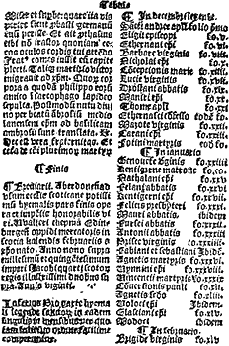
Colophon, Breviarum Aberdonensis, Pars Hyemalis.
(enlargement)
/ p.71 / duction of the work is boldly proclaimed, and there is no doubt that he is entitled to the merit of having been at the expense of printing the Aberdeen Breviary. Although his device is on both volumes, one could not conclude from the work itself that Chepman was the actual printer of it. The fact that he is constantly designated merchant has led some strongly to doubt it, and it would certainly be out of place for him to apply jussu to himself.
Just before the first volume was complete, certain merchants in Edinburgh infringed some of the rights and privileges which the letters patent of 1507 secured to Chepman and Myllar. Chepman appealed to the Privy Council, by whom his complaint was duly considered and decided in his favour. Neither in this complaint, nor in the pages of the Breviary, does Myllar's name appear, and it has consequently been assumed that he must have been dead at the time. We are loath, however, to drop acquaintance with Myllar so summarily, and we would fain believe that, although he does not figure in partnership with Chepman as printer of the Breviary, nor as a pursuer in the action noticed, he still continued to act as superintendent of the / p.72 / printing-house. Want of means may have prevented him sharing the expenses connected with the production of the Breviary, but he may have been willing to continue his services as a paid workman, allowing Chepman to reap all the glory and all the profit arising from the publication of so important a work.
We are inclined to think that with the completion of the Breviary Chepman's connection with printing came to an end. We believe he never viewed it in any other light than that of an ordinary money-making adventure; and we fear that in his own estimation, and perhaps in that of his contemporaries, his typographic career was looked upon as one of his most unprofitable speculations. Yet this was the grand event of his life — the one circumstance which has rescued his name from obscurity, if not oblivion, and ranked him among the benefactors of mankind.
We are led to infer that the printing materials were either sold or laid aside, from the fact that during the last fifteen years of Chepman's life, all the works of learned Scotchmen at home and abroad were printed on the Continent. With the single exception of the "Office of Our Lady of Pity," printed at Edinburgh by John Story, who
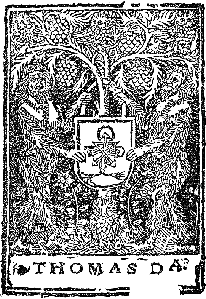
Device of Thomas Davidson.
(enlargement)
/ p.75 / is believed to have been the next Scottish printer, no books have been discovered with Scottish imprints until those bearing Thomas Davidson's name, who began to print about 1530. During this long interval the only resource was a return to the old state of affairs, when every sheet of printed matter had to be executed in a foreign land, entailing an amount of inconvenience unknown and scarcely conceivable by us at the present day.
M. A. CLAUDIN'S LETTERS TO THE AUTHOR.
I.
Mr. Tucker, Director of the "Typologie," forwarded to me your letter of the 7th instant. I beg to apologise, if prevented by business, I have not sooner answered so kind a letter from a Scotch booklover.*
---------------------------
* M. Claudin's Letters are not translations but are printed as written.—Editor.
---------------------------
For many years I have made researches respecting the typographical antiquities of France, and the origin of printing in the various places of this country. In the course of these researches, I often found names of foreign printers connected with the first typographical / p.78 / essays attempted in provincial towns. For instance, I have found the names of more than one English printer and bookseller having commercial intercourse with the printers of Normandy. When the name of Myllar occurred for the first time to me, I thought he was an English bookseller, like the others, and did not pay great attention to his name in the Catalogue Luzarche; I only pointed out that the types of the Sequentiæ Sarum were similar to the types employed by Hostingue, printer at Rouen and Caen. My object was only to prove that Hostingue, — like William Le Tailleur, Martin Morin, Peter Olivier, Robert Valentine and others, — had extended his business so as to print books for London booksellers.
When I was aware that Myllar was the introducer of printing into Scotland, I thought it necessary to have further information, the question presenting another aspect of high interest. I therefore ventured on the insertion of a letter in the "Typologie"; a letter followed immediately by a strong encouragement from the learned Mr. W. Blades, the historian of Caxton. Since then, I have made researches of all sorts on the subject. I think I shall soon be able to throw an additional light on so obscure a question. As soon as I find time to do it, I will write a dissertation as complete as possible on the origin of printing in Scotland, and have it privately printed.
According to my opinion, Androw Myllar is really the first introducer of printing into Scotland. Chep- / p.79 / man, named the first in the colophon of the first Edinburgh books, must be reckoned the second only. I think that Myllar, following the example of Caxton, went to the Continent to learn the secrets of the art of printing, and that during his apprenticeship he had books printed under his care, before his settling definitely in Edinburgh. The proof of what I advance is to be found in the Sequentiæ Sarum, with his device, printed with the date 1506, and in another earlier book of 1505, unknown to bibliographers, of which I send you the title and colophon. In this book it is clearly said:—"Andreas Myllar, scotus mira arte imprimi . . . prout facultas suppetebat . . . sollicitus fuit," according to his means (prout facultas suppetebat).
Androw Myllar was not rich enough to bear the expense of introducing the marvellous art of printing into Scotland, and was obliged therefore to take a partner in the person of Walter Chepman, a rich tradesman, and a man of great influence, attached to the person of King James IV. Androw Myllar very likely made a bad speculation; had the stock of his books printed on the Continent seized, or not allowed to be introduced into the Scotch kingdom. Walter Chepman as an importer had probably an interest in this stock of books; he pleaded his cause before the king, and obtained for both a privilege of printing. These facts assert themselves, I think, form the tenure of the privilege itself. I have obtained from the Record Office in Edinburgh, an entire and exact / p.80 / transcription of the original privilege granted to Chepman and Myllar, and I read these words: — "We have grantit and promittit to thame that thai sal nocht be hurt nor prevenit tharon be ony utheris to tak copyis of ony bukis furtht of our Realme, to ger imprent the samyne in utheris cuntreis, to be brocht and sauld agane within our Realme . . . and that na maner of sic bukis of Salusbery use be brocht to be sauld within our Realme, in tym cuming. . . ." I think the Sequentiæ ad usum Sarum, now in the British Museum Library, is alluded to in these last lines. Nearly all the copies must have been destroyed on account of this special prohibition. The first lines of the privilege relate expressly that the printing material was introduced from the Continent, with experienced workmen to use it. "Our lovittis servitouris Walter Chepman and Andro Millar, burgessis of our burgh of Edinburgh, has at our instance and request, for our plesour, the honour and proffit of our Realme and Liegis takin on thame to furnis and bring hame ane prent, with all stuff belangand tharto, and expert men to use the samyne. . . ."
Although Walter Chepman had a factor in Antwerp of the name of George Portus (c.f. Haliburton's Ledger, p. 11), the printing material was not brought from Flanders, or from the Netherlands, where the Scotch had a constant intercourse of business. The types used by Chepman and Myllar are not of any Dutch shape that I know: they have not the least / p.81 / appearance of being of the Dutch typographic family. I have looked over all the types of Dutch printers, and specially of Thierry Martens, Gherard de Leeu, and Veldener, the only Dutch printers who had something to do with the booksellers of London, and there is not the slightest appearance of conformity with the types used in Scotland. The great typographical market at the beginning of the xvi. century was Rouen, where nearly all the liturgical books of Salisbury, York, and other churches of England were printed on account and at the expense of English booksellers.
Therefore it is quite reasonable to suppose that Myllar, who had not yet entered into partnership with Chepman, went to Normandy rather than to the Netherlands to learn thoroughly the art of printing. Rouen was then a very flourishing place, and celebrated for the printing of English books. The very same year, 1505, Margaret, Countess of Richmond and Derby, sent Inghelbert Haghe to take care of the impression of the Missal of Hereford. Inghelbert Haghe used the presses of a printer of Rouen. In the dedication to his noble patroness, he says :— "Missalia jam honestissimis caracteribus et summa castigatione in Rothomagensi emporio magno certe impendio et solicitudine comprimenda curavi . . . Ex officina Rothomagensi cum illic gerens ad Idus Julias anno salutis . . . (1505.)" In another place, Rouen is called "in clarissimo Rothmagensi emporio, . . . et in famatissimo emporio," showing the reputation of the / p.82 / typographical city. The fact of a Norman printer having lent his presses to Enghelbert Haghe to print the Missal of Hereford is important, and may serve to prove that Myllar may have been allowed to do so, the same year, at the same place, according to the colophon of the Garlandus of 1505.
The types used by Chepman and Myllar at Edinburgh are undoubtedly of Norman shape and family. They are what we call gothique carée—square blackletter. This kind of type was used at first in Normandy at the end of the xv. century, towards the year 1490. Rouen furnished this type to other cities, viz.:—to Tours, Angers, and Lausanne in Switzerland, where Belst, a printer of Rouen, introduced his art in 1493. Evidently Rouen had special typographical foundries. By a careful examination of the types of Chepman and Myllar, I find they are all of Norman shape but they are mixed. Some capital letters belong to Richard Goupil, printer at Rouen; a great part belong to Hostingue, some belong to other printers — all Norman. I am almost sure that if I had at hand, and at once, specimens of all the types employed by the Rouen printers, I could trace all the types used by Chepman and Myllar except one, the type used for The Gest of Robyn Hode. This type has somewhat of a Dutch appearance, but I don't believe it is Dutch, for it is too badly cast, and looks like as if it had been worn out. I know all the Dutch types used at this period and do not know any printer having employed anything / p.83 / similar or approaching to it. My opinion is, that it is a type cast by Chepman and Myllar themselves. The rude woodcut of Robin Hood shows that Chepman and Myllar had an engraver amongst the experienced men they brought with the press to Scotland. This engraver may have tried to engrave, and to cast a new type. Printers at this time knew all the secrets of the art; Thierry Martens, John of Westphalia, John Veldener — all Dutch printers — say expressly in some of their colophons that they know how to engrave types, have them cast, engrave on wood, etc.
The device of Myllar is certainly engraved at Rouen: the engraving with the arms of France, the coats of arms bearing the three fleurs de lis at the top corners of the plate, show an evident connection with France, the country where Myllar served his apprenticeship. The device of Myllar is very well engraved, according to the taste of the period, but the rude engraving of Robin Hood is not by the same hand. If you look carefully at the device of Chepman, you will find the engraving, although better finished than the engraving of Robin Hood, is by the same hand. Look at the letters engraved Walterus Chepman; although the letters are taller, you will find a certain appearance of similarity that may induce you to think that the same hand that engraved the letters of Chepman's device may have been not uninterested in the engraving of the types of the text of Robin Hood.
This is a mere presumption, I confess, but if you / p.84 / recollect that Chepman and Myllar had no rival printer, their privilege being exclusive, you are induced to attribute to no other the different type employed in the text of Robin Hood. There is another remark I may make, the letter W in the text of Robin Hood is of the same height as the other letters, and in the other impressions of Chepman and Myllar this letter is much higher, showing that this letter, not used in the foreign Norman foundry, was rudely engraved, cast, and introduced afterwards in the composition by the first Scotch printers.
I intend to go to Rouen in May next, and there I will continue my researches on the question, and try to elucidate it as far as possible. I have already gathered many notes on the subject. I have carefully perused Haliburton's Ledger, edited by Mr. Innes, and the supplement to Dunbar's Poems by Mr. David Laing, where I have found all the particulars known relating to Chepman, but I should like to have a perusal of the articles written by you in the "Printer's Register." I will very likely receive from them a large amount of information on particulars that I am not aware of, that publication being unknown in France.
I am most obliged and indebted to you for your kindness in sending me the lot of facsimiles of the various impressions of Chepman and Myllar. Can I keep them for some time to study the question closely? I am obliged to have them continually at hand, but I take the greatest care of them, and if you will allow it, / p.85 / I will perhaps have some of them engraved for a clear demonstration.
I will have some questions to address to you to elucidate the documents I have gathered. Could you tell me if the Letter of Priviledge granted to Chepman and Myllar, by King James IV., has ever been published in full? I know only of extracts. If unpublished, I can publish it immediately, with a commentary.
Excuse so long a letter, and so badly written. Next time that I have leisure, I shall take great delight in sending you further information and questions. I enclose in this letter the title and colophon of the first book with the name of Myllar, printed in 1505, which I discovered. I have written to have the book itself in communication. If I do not succeed in having it sent, I shall undertake a journey to the place where I know the book is, and will try to have the title and colophon photographed. I will spare nothing to save if possible this monument of our first Scotch printer.
The honour of introducing the marvellous art of printing returns to poor Androw Myllar; Walter Chepman has the glorious share of having heartily helped him with his fortune. Myllar is really the Scotch Guttenberg, and if after what I know of him, I differ in announcing the fact to the bibliographical world, the reason is that if I put Myllar on his legs, I must put him at the same time in his own shoes, and therefore I am in need of a supplement of trustworthy information. For, nothing that is Scotch is indifferent / p.86 / to me. Although I bear a French name, I am of Scotch blood: my mother, from whom I received the first hints for antiquarian tastes, belonged to the well-known family of the historian of Scotland, Malcolm Laing, and I will feel proud if I can do anything to call attention to the old illustrious of my maternal country. Believe me, Dear Sir, yours very sincerely.
I have been most delighted with your last tidings. Your kind letter, your new facsimile, and your articles, have occupied my time with the greatest pleasure. Your articles on the Early Scotch Typography are very interesting, and full of good sound criticism. I have undoubtedly profited by them. In consequence, I reject my first opinion regarding the types of Robyn Hode. The beginneth shows pretty well the English origin of the book, and needs no further commentary. The type is very like that of a / p.87 / London printer, or of a provincial English printer unknown; it confirms my suggested hint of having been cast by an inexperienced founder of types.
Respecting the types signed by the names of Chepman and Myllar, viz.:—the types of the first nine pieces, I am almost sure they are of Norman origin, but I have not the means to ascertain it exactly. My first trip, in March or April, will be to the public libraries of Caen and Rouen, and then I shall examine very closely the types of each printer of these cities, and in the lot I will certainly find the right one from whom Chepman and Myllar brought the type number I of the first nine pieces. There is no other way conclusive.
Your opinion of a certain similarity with Wynkyn de Worde's types does not astonish me at all, and does not infirm in any way my opinion. Richard Pynson, a London printer, was Norman; Will Faques learnt typography from J. Le Bourgeois, a printer at Rouen. These two printers had types cast expressly for themselves in Normandy. Wynkyn de Worde must have bought types in Normandy also, and very likely from Peter Olivier and Jean de Lorraine, printers in partnership at Rouen. I have mentioned this last name because Wynkyn de Worde was himself from Lorraine, and it is natural to suppose that he bestowed his preference on a countryman.
Respecting the type of the tenth piece, it resembles very nearly the types of Hostingue, but some letters are mixed. I require a further examination with other / p.88 / books printed at Caen or Rouen, for I am not satisfied with a striking resemblance; I want a perfect similarity to conclude, and the case is not clearly demonstrated enough for me.
Of a perfect similarity between the types of the tenth piece, and the book with the fictitious colophon of 1558, there is no doubt in my mind. The book has not been printed in Paris at all, the name of Samuel Jascuij never existed. Jas is the abreviation [lit.] of James, and cuij means where or look after, search; the book of David Lindsay is very likely printed in Edinburgh by Thomas Davidson. Perhaps the water-mark of the paper will give the solution of the question.
The facsimile of Boece's Croniklis of Scotland interested me very much. The book is printed with the Norman types worn out of the shape of the types of the tenth piece. The letter E flourished, is copied from a similar letter I have just found in a book I suppose to be printed at Rouen. The original leaf I discovered in the cover of an old book some time ago. I send it to you and you may keep it. It will show you the trace of the pattern, or the origin of the Scotch types. Some capital letters, although not of the same size, are of the same shape, as the letters of the Breviary of Aberdeen. The most characteristic features of imitation are the letters A and M.
I send you the facsimiles you have been so kind as to lend me. When I go to Rouen I will very likely ask them again from you. I will require for some time / p.89 / more, if you will allow it, your articles extracted from the Printer's Register, a curious publication that I did not know. I have the Bibliophile by Berjean. I have found in it only an article concerning Thomas Davidson. Could you tell me at what page or year I am to find the article pointed out in your last letter.
I see with great pleasure that my opinion of Myllar is not different from yours. When I have at hand the Garlandus of 1505, I will tell you what I think of this fact. I proceed by ways of analogy, you proceed by other ways, but although we follow a different path, we may in the end arrive at the same conclusion. In the meantime you would oblige me very much if you could favour me with an answer to the questions I take the liberty to address you, with a view to a close study of obscure points in the question. If I do not trouble you too much, I shall have some other questions in reserve to address you. Your opinion is of so great weight in the balance that I dare not make a step in the question without your approbation.
With my best wishes all the year round, for you and your family, Believe me, yours most sincerely,
I beg a long apology for not having answered for a long time your most kind letters. I was so busy and overwhelmed with work that I had no time at all to do anything and was obliged to neglect my best friends and my best studies. In the end I fell into an illness, and was unable to do anything. Now I am much better, and I take the benefit of a little leisure to answer your letter of the 31st October, not delaying any more for fear I forget it in the midst of the bustle of business.
I have received your facsimiles, and have looked at them with great interest. If you allow me I will send you back some of them with my observations on the presumed origin of the types and of the ornamental letters, as soon as I shall be able to examine them more attentively. In the meantime, I answer the most important question in your letter.
The book bearing the name of Myllar, and the date 1505, belongs now to the National Library in Paris. I discovered the book many years ago in the library of / p.91 / a gentleman at Dinant in Bretagne. The owner was not aware at all of the value of the book, and was a singular man. He always promised to exchange it for another book that would have suited him better, but we could never agree what book he desired. Finally I offered to buy it from him at a large price. I could never obtain any agreement, although he wrote me that he would sell me the book. I made several excursions to the old city of Dinant, and asked at last permission to have the colophon of the book photographed. I could not obtain anything for years. At last the man died, and when the sale of his library took place, the book was advertised in the catalogue as being scarce. I decided to bid an immense price to secure the book, when a good friend of mine, Mr. Leopold Deslisle, the chief librarian of the Bibliotheque Nationale, asked my advice, telling me that the Library was desirous of buying it. I said to Mr. Delisle that I would run to £100 or more, but that I would not bid a farthing if the National Library desired the volume. Mr. Delisle gave me in consequence an order to buy it on behalf of that establishment at the price I thought necessary. We had some competition, but not very high. The book was knocked down at £16 or £17, I do not exactly remember the amount, that detail is not necessary, the important fact for you is to know that the book is now safe in a public establishment where any one can see it and examine it carefully. This is the history of the book and its vicissitudes.
/ p.92 /
Your second question is relative to the B. I do not know at all where this letter comes from. I will try to make some researches as soon as I am able to do it.
I am very glad to hear from you that you are much better in your health.
Yours truly,
PATENT, OR PRIVILEGE, GRANTED BY JAMES IV.
TO CHEPMAN AND MYLLAR.
JAMES, &c. to al and sindrj our officiaris liegis and subdittis quham it efferis, quhais knawlage thir our lettres salcum, greting; Wit ye that forsamekill as our lovittis servitouris Walter Chepman and Andro Myllar burgessis of our burgh of Edinburgh, has at our instance and request, for our plesour, the honour and proffit of our Realme and Liegis, takin on thame to furnis and bring hame ane prent, with all stuff belangand tharto, and expert men to use the samyne, for imprenting within our Realme of the bukis of our Lawis, actis of parliament, croniclis, mess bukis, and portuus efter the use of our Realme, with addicions and legendis of Scottis sanctis, now gaderit to be ekit tharto, and al utheris bukis that salbe sene necessar, and to sel the / p.94 / sammyn for competent pricis, be our avis and discrecion their labouris and expens being considerit; And becaus we wnderstand that this cannot be perfurnist without rycht greit cost labour and expens, we have grantit and promittit to thame that thai sal nocht be hurt nor prevenit tharon be ony utheris to tak copyis of ony bukis furtht of our Realme, to ger imprent the samyne in utheris cuntreis, to be brocht and sauld agane within our Realme, to cause the said Walter and Androu tyne thair gret labour and expens; And alis It is divisit and thocht expedient be us and our consall, that in tyme cuming mess bukis, efter our awin scottis use, and with legendis of Scottis sanctis, as is now gaderit and ekit be ane Reverend fader in God, and our traist consalour Williame bischope of abirdene and utheis, be usit generaly within al our Realme alssone as the sammyn may be imprentit and providit, and that na maner of sic bukis of Salusbery use be brocht to be sauld within our Realme in tym cuming; and gif ony dois in the contrar, that thai sal tyne the sammyne; Quharfor we charge straitlie and commandis yow al and sindrj our officiaris, liegis, and subdittis, that nane of yow tak apon hand to do ony thing incontrar this our promitt, devise, and ordinance in tyme cuming, under the pane of escheting of the bukis, and punising of thair persons bringaris tharof within our Realme, in contrar this our statut, with al vigour as efferis. Geven under our prive Sel at Edinburgh, the xv day of September, and of our Regne the xxti yer.
Aberdeen University Library, copy of Breviarium Aberdonense in, 63. Aberdeen, William Elphinstone, Bishop of, Chepman willing to gratify him, 15; his Breviary ready for the press, 27; his in- fluence with James IV., 61; his influence in introducing printing, 61; his Breviary, 61-75. Aberdonense, Breviarium, copy given to University of Edinburgh, 2; printing introduced for it, 61; printer of it doubtful, 62; reprint, 62; described, 62; copies known, 63; typography, 63; initial B, 64; title, 64; facsimile of title, 65; translation of title, 67; trans- lation of colophons, 67; writer of the colophons, 68; facsimile of colophon, 69. Act of Parliament anent printing the Acts, 3. Advocates' Library, Edinburgh, re- ceives a unique volume, 3; copy of Brev. Aberd. in, 63. Alston, Mr., of Glasgow, donor of volume of Chepman and Myllar's pieces, 3. Ames, Joseph, his Typographical Antiquities, quoted, 33. Antwerp, staple port at, 2. Athole, Earl of, burial place in St. Giles's, 20. Ayrshire, a unique volume picked up in, 3. Ballad of Lord Barnard Stewart, by William Dunbar, 8; facsimile of title, 8. Bibliotheque Nationale, purchases Garlandia, 39. Blackfriars Wynd, Edinburgh, Chep- man's printing office at the foot of, 16. Blades, William, on J. de la Caille's Histoire de l'Imprimerie, 3. Borough-muir, Edinburgh, buildings erected on by Chepman, 17. |
Breviarium Aberdonense, see Aber- donense. British Museum, purchases Expositio Sequentiarum, 32. Buke of Gude Counsale to the King, in unique volume, 7. Bumgart, Herman, printer, Cologne, types used in his Petrus Ravennas, 51; his Van xii fruchte misse zo hoeren, 52; facsimile of his de- vice, 58. Carkettle, see Kerkettle. Cases and Presses of Dutch make, 2. Catalogue of the Caxton Exhibition, quoted, 59. Cato cum Commento, printed by Goupil, 33. Caxton, William, on his device, 33. Chalmers, George, his typographical researches, 9. Chambers, Dr. William his restor- ation of St. Giles's, 20. Chepman, David, son of Walter Chepman, 18; receives his fa- ther's property, 19; gives the silver work to his mother, 20; survives his father, 21; a book- binder, 21; witness to John Chepman's deed, 21. Chepman, John, nephew of Walter Chepman, 21; endows a chap- laincy in his uncle's aisle, 21; his wife, 21; terms of his en- dowment, 22. Chepman, Robert, a witness to John Chepman's deed endowing a chaplaincy, 21. Chepman, Thomas, a witness to John Chepman's deed, 21. Chepman, Walter, merchant and burgess of Edinburgh, 2; Brev. Aberd. printed at his command and expense, 2, 62; associated with Androw Myllar, 3; his de- vice in the Maying, 4; his printing office, 4, 5, 7; Patent to, discovered, 9; quoted, 10; facsimile of his device, 12; our |
/ p.96 /
knowledge of, 13; native of Edinburgh, 13; enjoys friendship of James IV., 14; services at court, 14; sent with Stobo to English court, 14; general mer- chant and importer, 14; under- takes to establish a press, 15; not a practical printer, 15; invests money in land, 15; pur- chases Ewerland, 15; life-rents Meikle-Jergeray, 15; his wife Agnes Cockburne, 16; purchases Priestfield, 16; his printing office, 16; dwelling house, 16; Dean of Gild of Edinburgh, 16; builds on Borough-muir, 17; connection with a brewery, 17; exempted from duties, 17; receives grant of tavern and booth, 17; obtains charter of the king's meadow, 18; erects an aisle in St. Giles's, 18; endows a mortuary chapel, 19; enjoins prayers to be offered, 19; his death, 19; his burial in St. Giles's, 20; his remains dis- turbed, 20; his tomb, 20; his marriages, 21; his seal and sig- nature, 22; selected by the king to introduce printing, 27; prints a few books within seven months of the date of the patent, 28; his device described, 44; not the writer of the colophons in the Brev. Aberd., 68; his privileges infringed, 71; appeals and ob- tains favourable decision, 71; connection with printing ceases, 72; an unprofitable speculation, 72; printing materials sold or laid aside, 72. Chaucer, Maying and Disport, 1508, 4; facsimile of colophon, 4; of title, 4; of last page, 5. Claudin, A., draws up Catalogue La- zarche, 31; struck with Myllar's device in Expos. Sequent., 31; inserts facsimiles in catalogue, 31; his discoveries, 32; sends letter to La Typologie, 34; finds book printed by Myllar in 1505, 34; purchases it for the Biblio- theque Nationale, 39; our obli- gations to him, 41; letters to the author, 77-92. |
Cockburne, Agnes, second wife of Walter Chepman, 16; enjoys exemptions granted to her hus- band, 17; tenant for life of king's meadow, 18; prayers for her enjoined by Chepman, 19; de- livers Chepman's goods to her son, 19; receives the silver work from David Chepman, 20; her marriage, 21; her widowhood, 22. Cockburne, John, his tavern and booth escheated to the crown, 17. Coessin, Martin, of Exeter, books printed for, 33. Crammond Regis, Manor of, 15. Culross, Abbot and Monks of, sell life-rent of Meikle-Jergeray to Chepman, 15. Dais, co-heiresses of the name of, sell Ewerland to Chepman, 15. Davison, Thomas, printer, receives grant of premises formerly occu- pied by Chepman, 18; facsimile of his device, 74; commences printing, 75. De la Caille, J., author of Histoire de l'imprimerie et de la librairie, 3. Douglas, Gavin, Provost of St. Giles's Collegiate Church, Edinb., 18. Dunbar and Kennedy, Flyting of, 7. Dunbar, William, The Goldyn Targe, 7; facsimile of title, 7; Ballade of Lord Barnard Stewart, 8; facsimile of title, 8; Life and Poems of, by David Laing, quoted, 20. Edinburgh, University of, Brev. Aberd. presented to, 2; grants permission to take photographs of Breviary, 62. Eglamoure, Syr, of Artoys, 7. Elphinstone, William, Bishop of Aberdeen, see Aberdeen. Ewerland, Estate of, purchased by Chepman, 15. Exeter, Martin Coessin of, 33. Expositio Sequentiarum, titlepage of, 30; Myllar's device found in it, 31; colophon of, 32; pur- chased by British Museum, 32. |
/ p.97 /
Farquharson, Dr., presents volume of Chepman and Myllar's pieces to Advocates' Library, 3. Flyting of Dunbar and Kennedy, 7. Floddon, Battle of, 19. Garlandia, Johannes de, Multorum vocabulorum equivocorum inter- pretatio, 34; facsimile of title- page, 35; of colophon, 38. Gest of Robyn Hode, described, 51; facsimile of first page, 53; of second page, 55. Golagros and Gawane, Knightly tale of, 7; facsimile of title, 7. Goldyn Targe, by William Dunbar, 7; facsimile of title, 7. Goupil, Richard, of Rouen, prints for Martin Coessin of Exeter, 33. Haarlem, invention of printing at, 2. Hague, Catalogue of the Royal Lib- rary, quoted, 52. Harper, Isabel, placed by Chepman in the tavern in High Street, 18. Henderson, Isobel, wife of John Chepman, 21. Herbert, William, obtains from George Paton an account of the unique volume, 8; prints it in the appendix to his Typographical Antiquities, 9; quoted, 33. High Street, Edinburgh, Chepman's dwelling house in, 16; tavern and booth in, granted to Chepman, 17. Histoire de l'imprimerie et de la librairie, by J. de la Caille, translated in Watson's History, 3. History of the Art of Printing, by James Watson, 2; first British work on the subject, 3. Holland, printing introduced from, 2. Holtrop's Catalogue of the Royal Library at the Hague, quoted, 52. Hostingue, Laurence, Expositio Se- quentiarum printed with his types, 33; prints for Martin Coessin, 33. James IV., his Patent to Chepman and Myllar discovered, 9; dir- |
ectly intrumental in introducing printing, 10; a friend to Chep- man, 14; grants Chepman ex- emptions, 17; his fate at Floddon, 19; prayers for him endowed by Chepman, 19; a patron of learning, 26; a bibliophile, 27; selects Chepman and Myllar to introduce printing, 27; text of his Patent or Privilege to them, 93-94. James V., continues exemptions to Chepman, 17; gives him grant of tavern and booth, 17; grants same premises to Thomas David- son, 18; prayers for him enjoined by Chepman, 19. Kennedy, Flyting of Dunbar and, 7. Kerkettle, Margaret, first wife of Walter Chepman, 19; prayers for her enjoined, 19; her mar- riage with Chepman, 21. Knightly Tale of Golagros and Gawane, 7; facsimile of colo- phon, 7. Laing, Dr. David, on presentation of volume of Chepman and Myllar's pieces, 3; his Life and Poems of William Dunbar, quo- ted, 20; receives Catalogue La- zarche, 32; urges British Museum to purchase Expos. Sequent., 32; his opinion of the two last pieces in unique volume, 59. Lament for the Makars, facsimile of page of, 50. Lazarche, Victor, sale catalogue of his library, 31. Loys, Jamet, printer in Rouen, 33; prints for Martin Coessin, 33. Maying and disport of Chaucer, 4; facsimile of colophon, 4; of title, 4; of last page, 5. Maynyal, William, prints for Cax- ton, 33. Meikle-Jergeray, Life-rent of lands of, purchased by Chepman, 15. Murray, Earl of, tomb in St. Giles's, 20. Myllar, Androw, associated with Chepman, 3; his device in |
/ p.98 /
Maying, 4; his printing office, 4, 5, 7; Patent to, discovered, 9; quoted, 10; coadjutor of Chepman in establishing print- ing, 15; facsimile of his device, 24; is paid for books furnished to the king, 25; books bought from his wife, 26; last mention of his name, 26; a bookseller, 26; abroad in 1507, 26; selected by the king to introduce printing, 27; prints several books within seven months of the date of the patent, 28; in France, 31; his device found in Expos. Sequent., 31; French origin of his device, 33; prints Garlandia in France, 34; a genuine practical printer, 41; his device described, 44; his position during the printing of the Breviary, 71. Office of Our Lady of Pity, printed by John Story, 72. Orpheus and Eurydice, Tale of, 8; facsimile of title, 8. Parliament, Act anent printing Acts of, 3. Patent or Privilege to Chepman and Myllar discovered, 9; quoted, 10; text of, 93-94. Paton, George, Edinburgh, furnishes Herbert with an account of the unique volume, 8. Perthshire, Meikle-Jergeray in, 15. Pigouchet, Philippe, his device de- scribed, 44; facsimile of his device, 45. Porteous of Noblenes, 4; facsimile of colophon, 7. Priestfield, now Prestonfield, pur- chased by Chepman, 16. Printing, History of the Art of, by James Watson, 2; first British work on the subject, 3. Quaritch, Bernard, on Gest of Robyn Hode, 52. Ravennas, Petrus, Compendium Juris Civilis, types used in, 51. Riccardton, James Wardlaw of, 16. |
Robertson, William, discovers the Patent or Privilege to Chepman and Myllar, 9. Robyn Hode, Gest of, described, 51; facsimile of first page, 53; of second page, 55. Rouen, printers in, 33. St. Andrews, Scotland's Complaint printed at, 3. St. Giles's Collegiate Church, Edin- burgh, aisle erected by Chepman, 18; mortuary chapel endowed by Chepman, 19; Chepman's burial in, 20; Chepman's tomb in, 20; chaplaincy at altar of St. John in Chepman's aisle endowed, 21. Scotland's Complaint, 3. Scottish Arms, edited by R. R. Stoddart, quoted, 22. Sequentiarum, see Expositio Se- quentiarum. Spotswood, John, Advocate and Professor of Law, author of preface to Watson's History, 2. Stanbrigius, see Vocabula. Stewart, Lord Barnard, see Ballad of. Stoddart, R. R., his Scottish Arms quoted, 22. Story, John, prints Office of Our Lady of Pity, 72. Strathmore, Earl of, his copy of Brev. Aberd., 63. Syr Eglamoure of Artoys, 7. Tale of Orpheus and Eurydice, 8; facsimile of title, 8. Tucker. La Typologie, receives letter from A. Claudin, 34. Vocabula Magistri Stanbrigii, print- ed by Hostingue and Loys, 33. Wardlaw, James, of Riccardton, sells Priestfield to Chepman, 16. Watson, James, his History of the Art of Printing, 2; first British work on the subject, 3; ignorant of the first Scotch Press, 3. Who was Scotland's First Printer ? 52. |
|
|
